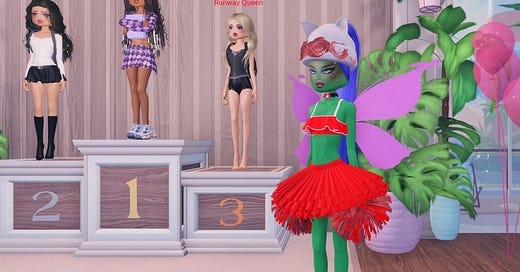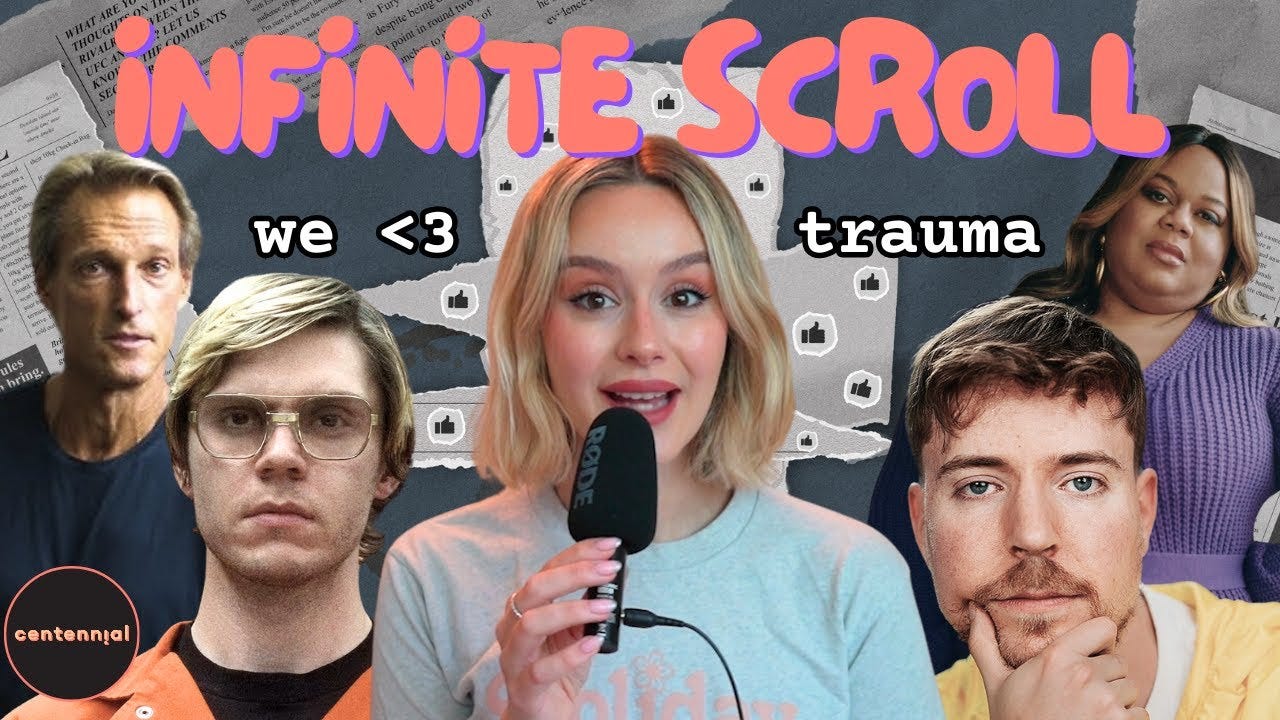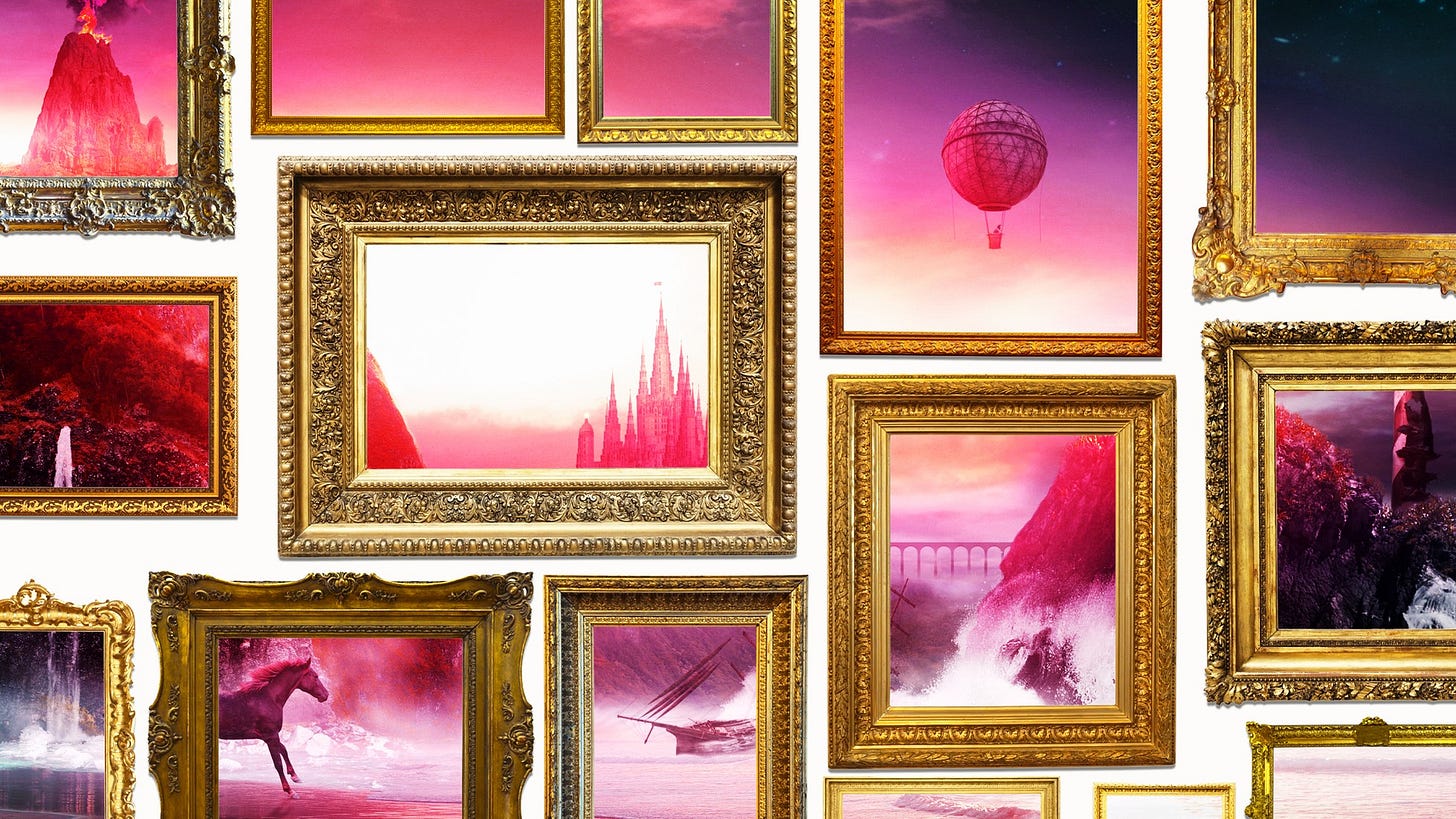Keep scrolling for why Gen Z hates flirting.
What is Dress to Impress, and why is everyone so obsessed?
From Stardoll to The Sims, many of us have spent countless hours designing avatars, choosing everything from outfits to makeup and hair. For many, this is the highlight of the gaming experience. Now, a new game that taps into this process is making waves on TikTok: Dress To Impress (also known as DTI). In a new piece for Dazed, Thom Waite explores why DTI is taking over the short-form video app.
DTI isn’t actually a TikTok filter or game, despite its success on the platform. It is a game on Roblox, developed by a user known as Gigi, who is said to be only 17 years old.
For those who are unfamiliar with the DTI, players have around five minutes to dress a blank avatar according to a random theme. These themes can range from Y2K to K-pop to disco.
Once you’ve rushed to style your avatar, you hit the runway, strike a pose, and rate other players' outfits. But beware—players can be ruthless, often dishing out harsh one-star ratings.
Though DTI has been around for over a year, it’s recently seen a surge in popularity, largely thanks to TikTok.
Gen Alpha and younger Gen Z primarily dominate Roblox. But with TikTok virality, DTI has attracted older users— including Madison Beer, who’s started streaming her gameplay on Twitch.
Even Charli XCX has given the game her stamp of approval, with a recent brat-themed update making the DTI world perfect for brat summer.
As for why the game is so popular, Waite claims that it has something to do with nostalgia.
“Despite the plasticky graphics and proximity to games for literal babies, adults have gone all-in on the backstage-styling-meltdown simulator,” he writes. “Is it all a bit tongue-in-cheek, ironic, or driven by nostalgia? Probably, yes. Is it also very addictive once you get started? I confess, I did not want to log off.”
Read the full story via Dazed.
Why Creators Have Stopped Editing Their Content
With many social media users enjoying DTI streams, it’s clear that longer-form, real-time content is a powerful way to connect with an audience. But this approach isn’t just for live streams. As Taylor Lorenz points out in Rolling Stone, more creators are embracing unedited, chatty content across social media platforms.
Creators like Dan Hentschel, for example, will record themselves casually talking for up to 40 minutes in their car before posting it directly to YouTube. This raw, conversational style is becoming a popular way to build deeper connections with followers.
“The whole reason why people are enjoying this form of content is because it feels spontaneous, because it feels like it’s somebody who’s just talking to you,” he tells Lorenz.
Alongside Hentschel, a whole class of similar creators has emerged. Whether they focus on fitness, business, or lifestyle, they all embrace unedited content, talking straight to the camera without cuts.
“After years of drowning in so-called retention-edited content, packed full of souped-up graphics, bold text onscreen, sound effects, and visual elements, audiences are gravitating toward more stripped-down, unedited videos, giving these emerging creators a boost,” Lorenz writes.
Interestingly, creators known for their highly produced videos, filled with jump cuts and animations, are beginning to take a step back.
Lorenz points to MrBeast as one example, noting that he has “slowed” down on the editing to focus more on “storytelling” and showcasing genuine “personality.”
Not only is this approach less labour-intensive, allowing creators to produce content more efficiently, but it’s also far less costly. With lower production costs and minimal editing, creators can publish videos more frequently, increasing their chances of one going viral.
Unedited content is even outperforming well-edited videos, Lorenz adds, with many industry experts capitalising on this trend as a new way to connect with Gen Z.
“The videos that perform the best are videos that don’t have text overlays, or cuts, or special effects…They’re usually just continuous clips,” Adam Meskouri, who negotiates licensing partnerships with creators, tells the journalist.
Read the full piece via Rolling Stone.
The Internet & Traumaporn: The "ethical" consumption of tragedy in the digital age
In a recent deep dive for the ‘infinite scroll podcast',’ host Lauren Meisner explores the rise of traumaporn on the internet, why social media users can’t seem to look away, and how creators are profiting from this type of content.
Meisner explains that traumaporn is often capitalistic, unproductive, and exploitative, as it commodifies trauma for monetary gain without providing solutions or constructive dialogue.
She also acknowledges related concepts, such as "tragedy porn" and "poverty porn," which similarly exploit various issues and situations as plot devices.
Ever since the 2020 Black Lives Matter protests, traumaporn has become ubiquitous on social media.
At the time, the videos of George Floyd and police brutality compelled many white people to confront their privilege. However, many Black communities have criticised this type of content, as it often forces them to relive their trauma and intergenerational pain for the benefit of the majority—specifically white, straight, cisgender, and neurotypical audiences.
Meisner quotes on Brittany Johnson’s piece for The Mighty saying, “When traumaporn is created surrounding the ‘experience,’ to put it lightly, of what it means to be marginalized, it is never made with the marginalized group in mind. Thus, the art can further trigger said marginalized group.”
Meisner goes on to explain why many social media users are drawn to traumaporn, noting that it is a form of slacktivism.
"Many people, especially white people, might have used this traumatic content to perform allyship. Because of this element of performance, online activism is sometimes referred to as slacktivism—an effort-free way for someone to perform activism or allyship without actually having to take their efforts offline," she says.
But this isn’t limited to social media users; creators also leverage traumaporn to their advantage. In our attention-driven economy, where social media platforms constantly compete for our focus, trauma can be a powerful tool to attract and engage audiences.
Numerous creators use trauma to grow their followings, generally falling into two categories: those who exploit their own trauma and those who use the trauma of others for personal gain. Soft White Underbelly and MrBeast are notable examples of the former.
With that being said, Meisner concludes by questioning what audiences can do about traumaporn.
“[Our] penchant for “bad news” is nothing new and it’s unlikely that people will stop creating, consuming, and engaging with traumatic content,” she says. “Staying critical of who is creating this content and why they’re creating it is probably the bare minimum we can do to support the people who were actually involved in these real life tragedies… before we turn them into traumaporn content,” she says.
Tune into the ‘infinite scroll’ podcast on Spotify, Apple Podcasts, and YouTube.
Why Does AI Art Look Like That?
While traumaporn is popping up more and more frequently on social media, so is AI-generated art. In a new piece for The Atlantic, Caroline Mimbs Nyce explores why AI image generators tend to produce similar-looking content.
From Midjourney to DALL-E, there are already quite a few AI art programs on the market. X (formerly Twitter) is one of the latest companies to jump on board, with the xAI Grok chatbot.
Mimbs Nyce notes that more AI art tools are on the way, with Google set to introduce Pixel Studio and Apple launching Image Playground later this year.
Even as these programs become increasingly advanced, the journalist notes that all pictures seem to have the same vibe and aesthetic.
“The colors are bright and saturated, the people are beautiful, and the lighting is dramatic. Much of the imagery appears blurred or airbrushed, carefully smoothed like frosting on a wedding cake. At times, the visuals look exaggerated. (And yes, there are frequently errors, such as extra fingers),”she writes.
As for why all these images look similar, Mimbs Nyce arrived at four possible explanations after consulting with industry experts.
Many models are trained on extensive libraries of photos paired with text descriptions. These tools can pick up on existing biases within the data sets, ”whether that’s racial or gender bias, or something as simple as bright colors and good lighting.”
A technique called diffusion might contribute to the uniformity across these images. This method involves adding "noise" to images—something that Mimbs Nyce likens to "TV static." Since many companies use diffusion, this could result in a similar visual outcome across different platforms.
Of the process, the journalist explains, “[The AI model] is trained to remove this noise, over and over, for tens of thousands, if not millions, of images. The process repeats itself, and the model learns how to de-noise an image. Eventually, it’s able to take this static and create an original image from it.”
She also notes that AI image generators might be learning from human feedback. This feedback loop could further reinforce various similarities, as the models adapt to the critiques they receive.
“If people are downloading art that tends to have really dramatic sunsets and absurdly beautiful oceanscapes, then the tools might be learning that that’s what humans want, and then giving them more of that,” Mimbs Nyce hypothesises.
Finally, developers might have integrated human preferences into their programs. The journalist suggests that this could be a way for companies to capitalise on trends or, unintentionally, a method to minimise bias in the models.
Whether it’s one of these reasons or all four, it’s clear that AI-generated content is dominating social media. While the unique vibe of AI images makes it relatively easy for users to tell them apart from real content, it may not be that way forever.
“Someday computer-generated art may shed its weird, cartoonish look, and start to slip past us unnoticed,” Mimbs Nyce concludes. “Perhaps then we’ll miss the corny style that was once a dead giveaway.”
Read the story via The Atlantic.
Why Gen Z hates flirting
With dating apps being a major part of Gen Z’s dating landscape, it’s clear a lot has changed in the dating world over the last decade. While these apps have certainly helped people connect, recent research from Bumble shows that many young people still feel out of their depth when it comes to flirting.
According to Bumble’s research, only 7% of single Gen Z and Millennials feel very confident in their flirting abilities, and over 4 in 5 singles say flirting makes them feel ‘self-conscious.’
While there is no denying that flirting can make you feel exposed, Bumble maintains that it is an important and positive part of dating.
To help Gen Z embrace the art of flirting, Bumble has appointed a Chief Flirting Officer to encourage users to lean in to this part of dating culture.
“At its core, it’s [flirting is] about playful communication and showing genuine interest in another person. We need to rediscover and redefine what flirting means in today's world, ensuring it remains a positive and engaging experience,” Bumble’s newly-appointed Chief Flirting Officer Chantelle Otten says.
Whether by sending memes or hanging out in person, flirting might help Gen Z navigate the often complicated dating world and become more comfortable talking to new people. And at the very least, it might offer some entertaining storytimes to share on TikTok.










